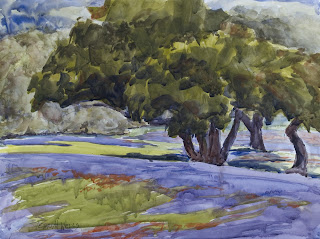
I was driving through the Painted Desert out west with my artist travel buddy, Denise Mahlke, when a springtime dust storm came up. The gusty wind was so strong, we couldn’t see the cars ahead of us. Separate colors passed in front of our windshield changing like the horse of a different color in “Wizard of Oz” First peach, then green , then purple, then yellow….
When we came out of the desert into a canyon, the wind had stopped. There were all the rocks that were the colors that blew in front of our windshield. Late afternoon lighting created an awe-inspiring scene before us. Only one other time (in a huge field of bluebonnets) had I become speechless and unable to paint. I was reduced to one stroke of watercolor for each rock following the canyon wall vertically. At one point, the audacity of God’s work caused me to laugh out loud.
I left the canyon with written notes, rock samples, photographs, and one small sheet of color notations. A few weeks later, with trip paintings and reference materials scattered about my studio, I noticed the brush stroke color notations and it struck me. Time to build another wall sculpture! I’m titling it “In God’s Paint Box”.
Follow future posts about constructing this sculpture and as well as other paintings. The sculpture was a process that took 18 months from the original on-location sketch to completion.





